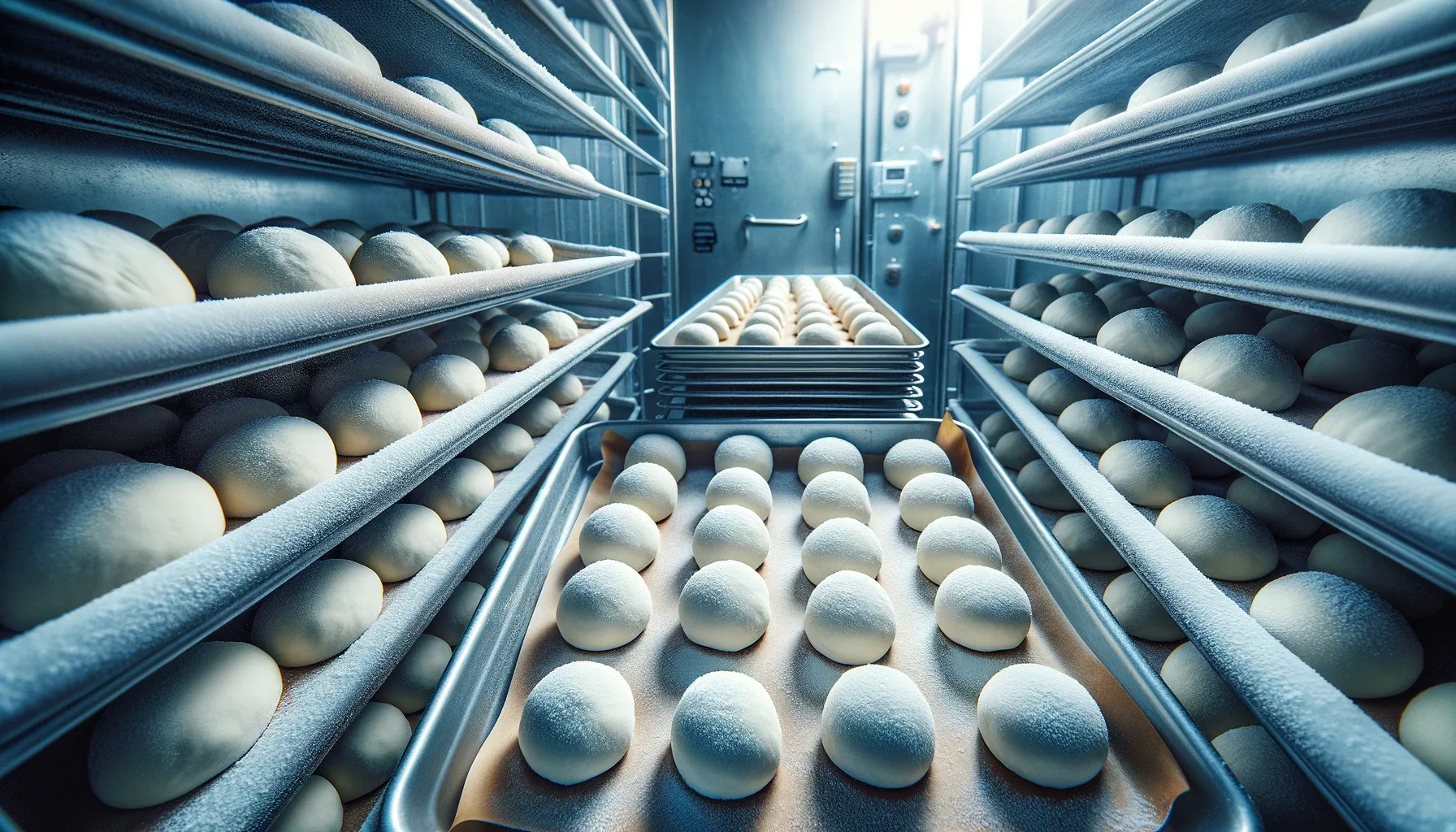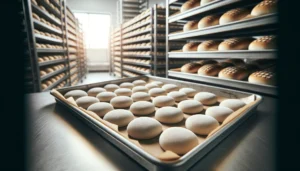The Potential of Frozen Dough Technology
The frozen dough sector is a dynamic component of the commercial bakery industry, offering significant opportunities for growth and innovation.
As consumer preferences evolve and demand for convenience rises, frozen dough technology stands at the forefront of revolutionizing baking practices.
In this article, we’ll discuss the latest trends, challenges, and advancements in frozen dough production, storage, and baking techniques, with a focus on maintaining quality and embracing clean label products.
Production of Frozen Dough
Current State of the Market
The frozen dough market is experiencing robust growth, driven by increasing consumer demand for bakery products and the continuous expansion of the food service industry.
The market is projected to grow at a compound annual growth rate (CAGR) of approximately 5.4% from 2024 to 2034. Innovations in product offerings, such as gluten-free and low carb, keto-friendly options, are tapping into new consumer segments and creating lucrative growth opportunities for manufacturers.
Technological Advancements
Modern production technologies are integral to the efficiency and scalability of frozen dough manufacturing. Advances in freezing technologies ensure that the quality of dough is maintained from production to thawing, crucial for meeting consumer expectations for taste and texture.
The industry has seen significant technological improvements, including better refrigeration methods and enhancements in ingredient mixing that preserve the dough’s integrity during freezing and baking.
The frozen dough market is projected to grow at a compound annual growth rate (CAGR) of approximately 5.4% from 2024 to 2034.
Market Innovations
Several companies are leading the way with innovative solutions in the frozen dough sector. For example, companies like Puratos have developed unique frozen bread solutions that cater to both consumer expectations and bakery operation challenges, highlighting the sector’s shift towards more specialized products.
These innovations not only enhance the product quality but also address the logistical and practical challenges faced by bakeries, such as the need for longer shelf-life and consistent performance in baking.
Storage Solutions for Frozen Dough
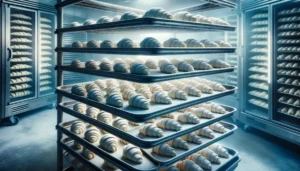
The Importance of Effective Storage
The storage of frozen dough is crucial for preserving its quality and ensuring optimal results during baking. Effective storage not only extends the shelf life of the dough but also maintains the yeast viability, texture, and flavor that are essential for high-quality bakery products.
The challenges of frozen dough storage include preventing freezer burn and managing the dough’s exposure to fluctuating temperatures, which can degrade its quality.
Advanced Storage Technologies
Advancements in storage technology are pivotal in addressing these challenges. Modern freezing technologies, such as blast freezing, play a critical role in rapidly lowering the temperature of dough, thus minimizing ice crystal formation that can damage gluten structure and yeast cells.
This technology ensures that the cellular structure of the dough remains intact, preserving the leavening power for when the product is baked.
In addition to freezing techniques, the industry is seeing innovations in packaging that contribute to longer shelf life and better quality. Using inert gases in packaging, for example, can prevent oxidation and moisture loss, key factors in maintaining dough quality during extended storage periods.
These packaging solutions are designed to keep the frozen dough in an optimal state from the production line until it reaches the oven.
Strategic Storage Practices
Effective inventory management is also essential for maintaining the quality of frozen dough. Bakeries and food service providers are increasingly adopting smart inventory systems that help track the age of the dough and ensure that older stocks are used before they begin to deteriorate. Such systems are crucial for large operations where the volume of dough handled can make manual tracking inefficient.
Industry Best Practices
Leading companies in the frozen dough sector employ a combination of advanced technologies and strategic practices to optimize their storage solutions. They focus on continuous improvement and adherence to strict quality control measures throughout the storage process.
This approach not only improves the efficiency of the storage system but also enhances the overall quality and consistency of the final baked products .
Gluten-Free and Specialty Diets
Another notable trend is the increasing demand for gluten-free and other specialty diet products. As awareness of celiac disease and gluten sensitivity continues to rise, so does the demand for gluten-free bakery items.
Manufacturers are responding by developing innovative frozen dough products that cater to this need while maintaining the sensory qualities of their gluten-containing counterparts. This segment’s expansion is not just limited to gluten-free options but also includes products designed for other dietary restrictions, such as vegan and keto-friendly foods.
Technological Advancements
Technological advancements in production and freezing techniques are also pivotal trends. The use of cryogenic freezing, which involves ultra-low temperatures, is becoming more popular as it helps better preserve the texture, flavor, and aroma of the dough compared to traditional freezing methods.
Additionally, automation in dough mixing and handling processes is on the rise, which helps increase production efficiency and consistency in product quality.
Sustainability Practices
Sustainability is increasingly becoming a key consideration in the frozen dough sector. This involves the adoption of practices that reduce waste, energy use, and overall environmental impact.
Manufacturers are investing in more energy-efficient freezing and storage solutions and are more frequently using sustainably sourced and organic ingredients. The packaging is also a focus, with a shift towards materials that are recyclable or biodegradable.
Customization and Personalization
Finally, customization and personalization are driving innovation in the frozen dough industry. Consumers are looking for products that can be tailored to their tastes and preferences, whether in terms of flavors, shapes, or ingredients.
Manufacturers are leveraging flexible production techniques to offer a broader array of customized options, particularly for niche markets. This trend is also seen in the rise of regional flavor variations, catering to local tastes and dietary habits.
Challenges with Traditional Dough Formulas in Frozen Applications
Quality Deterioration Over Time
One of the primary challenges in the frozen dough industry is maintaining the quality of bread and other bakery products over time.
Traditional dough formulas, when subjected to freezing and prolonged storage, can suffer from significant quality deterioration. This is particularly evident in the bread’s texture and flavor profile, which can become noticeably less appealing. The freezing process can damage yeast activity and gluten structure, leading to less effective leavening and a denser, tougher bread once baked.
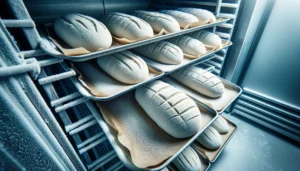
Dependency on Additives for Quality Preservation
To counteract these effects, many manufacturers rely on various dough improvers like emulsifiers, enzymes, and hydrocolloids. These additives help stabilize the dough and preserve its quality during freezing and thawing cycles.
Emulsifiers, for instance, can improve dough strength and gas retention, enhancing the bread’s volume and softness after baking. However, the use of such additives can complicate product labels, which may deter consumers seeking clean label products that are free from artificial ingredients.
Natural Alternatives and Clean Label Challenges
The shift toward clean label products poses additional challenges, as it limits the use of synthetic additives traditionally employed to protect frozen dough’s integrity. This has spurred interest in natural alternatives that can perform similar functions without compromising the label’s simplicity. Ingredients derived from natural sources, such as ascorbic acid (vitamin C) or various plant extracts, are being tested for their effectiveness in improving the tolerance of frozen dough to freezing and thawing.
Innovation and Research Needs
There is a substantial need for continued innovation and research in this area. The industry is exploring new formulations and processing techniques that can extend the shelf life and enhance the quality of frozen dough products without relying on undesirable additives. This includes advances in cryogenic freezing techniques, which can reduce ice crystal formation and better preserve the dough’s cellular structure.
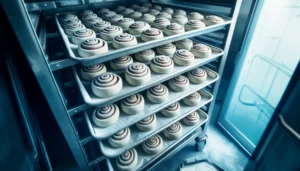
Innovating with Keto PowerFlax Baking Mix
Innovations in frozen dough are not just about improving existing products but also about introducing new, healthier options that cater to specific dietary needs.
One such innovation is the Keto PowerFlax Baking Mix, a versatile ketogenic flax seed baking mix that is transforming the frozen dough sector. This clean-label, plant-based mix is not only keto-friendly but also rich in fiber, protein, and omega-3 fatty acids, making it an excellent choice for health-conscious consumers.
A significant advantage of using Keto PowerFlax is its inherent stability during freezing. Unlike traditional doughs that often require the addition of emulsifiers, conditioners, or dough enhancers to maintain integrity during freezer storage, Keto PowerFlax does not require any such additives.
This absence of artificial improvers is a huge benefit for commercial bakeries, both in terms of cost and time savings and in enabling the production of a more natural or clean label end product.
Due to its high omega-3 content, dough made with Keto PowerFlax does not develop freezer burn during storage, maintaining its flavor and texture perfectly. This makes it ideal for commercial bakeries looking to offer a ‘freezer to oven’ program that delivers a scratch baking experience without the need for artificial improvers.
By utilizing Keto PowerFlax, bakeries can cater to health-conscious customers who demand transparency and purity in their food products. This approach not only meets consumer expectations for natural ingredients but also enhances the appeal of frozen dough products in the marketplace.
As the clean label trend continues to grow, products like Keto PowerFlax Baking Mix are likely to become increasingly important for bakeries looking to innovate and expand their customer base.
Unlike traditional doughs that often require the addition of emulsifiers, conditioners, or dough enhancers to maintain integrity during freezer storage, Keto PowerFlax does not require any such additives.
This absence of artificial improvers is a huge benefit for commercial bakeries, both in terms of cost and time savings and in enabling the production of a more natural or clean label end product.
Final Thoughts
The field of frozen dough technology offers tremendous opportunities for commercial bakeries to innovate and meet evolving consumer demands. By focusing on the development of clean label products, leveraging advanced freezing technologies, and tailoring offerings to consumer preferences, the industry can overcome the challenges associated with traditional dough formulas.
The continued push towards more natural and sustainable production methods also presents a unique chance to redefine industry standards and enhance consumer trust and satisfaction. As the industry moves forward, embracing these innovations will be key to sustaining growth and maintaining competitiveness in a rapidly changing market landscape.
References
- Frozen Dough Market Size, Share, Trends & Forecast by 2034 | FMI
- Frozen Dough & Batter Production in the US – Market Size, Industry Analysis, Trends and Forecasts (2024-2029) | IBISWorld
- Frozen Dough Market Size, Growth, Share, Trends | 2024 to 2029 | MarketDataForecast
The Next Step

- You can easily produce delicious keto-friendly products which are clean label, high protein, high fiber and plant-based!
- Recipes provided on all bulk orders, with ongoing customer support
- Ideal for frozen dough applications
- Worldwide shipping and ongoing customer support
- To order, visit our wholesale distributor, SnowCap Enterprises, and search: Powerflax Gold Low Carb Mix (SNC80).
- Let’s talk – just fill out the form below!

